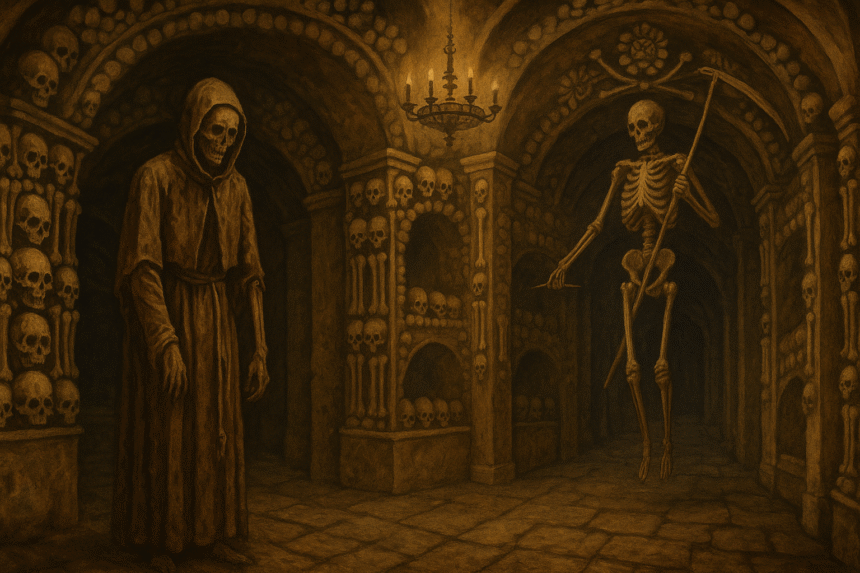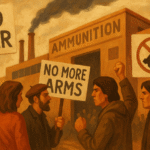Beneath the bustling streets and grand basilicas of Rome lies another world — one steeped in faith, history, and a haunting reminder of mortality. While the Eternal City dazzles visitors with treasures such as Michelangelo’s Sistine Chapel and Caravaggio’s masterpieces at San Luigi dei Francesi, its underground sanctuaries reveal a far more somber side of Christianity’s past.
The Capuchin Crypt: A Macabre Testament to Mortality
Perhaps the most chilling of Rome’s sacred spaces is the Capuchin Crypt, located beneath the Church of Santa Maria della Concezione dei Cappuccini on Via Vittorio Veneto. Created in the 18th century, the crypt is adorned with the bones of more than 3,700 Capuchin friars. The ossuary’s six chambers—bearing names like the Crypt of Skulls and the Crypt of Tibias and Femurs—use human bones to form intricate patterns, arches, and even chandeliers.
A sign within the Crypt of the Three Skeletons reads, “What you are now, we used to be; what we are now, you will be.” It encapsulates the crypt’s purpose as a stark meditation on the brevity of life and the inevitability of death. Despite its eerie ambiance, the crypt reflects a deep spiritual message: that death is merely a transition to eternal life, echoing centuries of Catholic belief.
Rome’s Ancient Catacombs: The Cradle of Christian Burial
Beyond the Capuchin Crypt, the city’s ancient catacombs—vast labyrinths of tunnels outside the old city walls—offer a more reflective encounter with early Christian history. Dating from the 2nd to 5th centuries, these underground cemeteries served as burial grounds during a time when interments within Rome’s walls were forbidden.
Early Christians viewed these spaces as “dormitories of the dead,” awaiting resurrection. Although the catacombs were later looted by invaders and relic hunters, they remain among the most sacred archaeological sites in Rome, now supervised by the Vatican’s Pontifical Commission for Sacred Archaeology.
Visitors today walk through narrow, dimly lit corridors lined with thousands of loculi — small burial niches stacked in tiers, some barely large enough for infants. The walls are etched with Christian symbols like fish, anchors, and doves, alongside Latin inscriptions and Renaissance graffiti left by early archaeologists. Fragments of marble sarcophagi and frescoes, depicting biblical scenes such as Noah’s Ark or Christ as the Good Shepherd, offer glimpses into the birth of Christian art.
Exploring the Catacombs: Seven Sites Beneath the Eternal City
Rome hosts dozens of catacombs, though only a handful are open to the public. Among the most notable are:
- Catacomb of Saint Callixtus: Known as “The Little Vatican,” this site once held the remains of early popes and martyrs like St. Cecilia. It is illuminated for visitors and features a ninth-century fresco of Christ the Teacher.
- Catacomb of Saint Sebastian: Offers a quieter, more authentic experience, where pagan mausoleums stand near humble Christian tombs.
- Catacomb of Domitilla: Originally the burial site of a noble Roman family, it combines pagan and Christian symbols and retains remarkable frescoes despite centuries of looting.
- Catacombs of Saints Marcellinus and Peter: Dedicated to two 4th-century martyrs, this site houses frescoes depicting both Old and New Testament scenes and an underground chapel marking their resting place.
- Catacomb of Priscilla: Often called the “Queen of the Catacombs,” it features early depictions of the Madonna and Child and frescoes illustrating a woman’s life through three stages.
- Catacomb of Saint Agnes: The smallest and least visited, offering a peaceful, solitary exploration near a metro stop.
- The Capuchin Crypt: While technically not a catacomb, it remains the most macabre and unforgettable experience for visitors seeking to confront mortality face-to-face.
A Journey into Faith and Fragility
Exploring these underground sanctuaries reveals more than Rome’s artistic or architectural evolution — it uncovers the early Christian worldview that embraced death not as an end, but as a passage. The catacombs and crypts serve as powerful reminders of a civilization deeply rooted in faith, humility, and the hope of resurrection.
For many visitors, these haunting yet sacred spaces offer a profound encounter with history — a reminder that beneath Rome’s splendor lies a city of bones, faith, and eternal questions.








